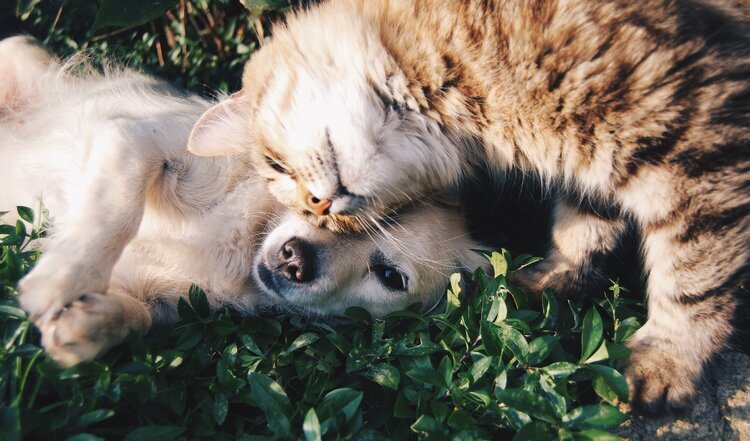Chemotherapy in Pets
What is chemotherapy? When is chemotherapy recommended in pets? How is it different in humans and pets? What are the side effects? Vets, here are some answers to some ‘Frequently Asked Questions’ about chemotherapy in dogs & cats.
What is chemotherapy?
Chemotherapy are drugs that are toxic to cancer cells, which multiply rapidly. Most chemotherapy drugs work by damaging the ability of cancer cells to divide and replicate. It is administered at the highest maximum tolerated dosages to try to stop cancer cell growth and thus, kill cancer cells.
When is chemotherapy recommended in pets?
Chemotherapy is recommended in pets for one or more of the following reasons:
To reduce or eliminate cancer (e.g. lymphoma)
To slow the progression of cancer
To treat cancer spread (i.e. metastasis)
To prevent or delay the onset of metastasis (i.e. adjuvant therapy)
To alleviate problems associated with the tumour (such as pain) and thus, improve the pet’s quality of life (i.e. palliation)
To reduce the size of the tumour to allow for surgery (i.e. neoadjuvant therapy)
To improve the response to other anti-cancer therapies such as radiation therapy (i.e. radiosensitisation)
How is chemotherapy different in humans and pets?
In human medicine, the main objective of chemotherapy is to eliminate all cancer cells to try to obtain a cure. Chemotherapy is usually administered more aggressively and has more chances of developing side effects.
Pets tolerate chemotherapy far better than humans. This is because chemotherapy is administered at much lower dosages to try to prevent side effects. The primary goals of chemotherapy in pets are to slow the progression of cancer and minimise discomfort while striving to maintain or improve the pet’s quality of life.
What are the side effects of chemotherapy?
Chemotherapy aims to disrupt cancer cell division by targeting rapidly dividing cells. It will not know the difference between rapidly dividing cancer cells and normal tissues. Thus, side effects may occur to the normal, rapidly dividing bone marrow, hair follicles and gastrointestinal tract.
The easiest way to remember chemotherapy side effects is by remembering ‘BAGS’.
B = Bone marrow suppression
A = Alopecia (However, most pets do not become bald like in people)
G = Gastrointestinal side effects
S = Specific/special side effects related to a particular drug. For example, doxorubicin can cause cumulative cardiotoxicity.
How common are chemotherapy side effects in pets?
Pets experience fewer and less severe side effects than humans. Approximately 80% to 90% of pets that receive chemotherapy experience no side effects. About 10% to 20% of pets experience a chemotherapy side effect (e.g. gastrointestinal signs), which can often be managed with supportive home medications. Approximately 5% of pets experience a chemotherapy side effect that requires hospitalisation (e.g. sepsis). Less than 1% of chemotherapy side effects unexpectedly results in death.
When do chemotherapy side effects typically occur?
There are two main types of chemotherapy side effects. Gastrointestinal side effects and sepsis and/or infection.
Most gastrointestinal side effects occur 3-5 days after administration. Gastrointestinal side effects are typically mild and temporary. Some pets require supportive medications during chemotherapy. Rarely do pets experience severe gastrointestinal side effects requiring hospitalisation.
For most chemotherapy drugs, sepsis and/or infection usually occurs around 7 days after administration. This is because the neutrophil count drops to the lowest point around 7 days after administration. If the neutrophil count is <1.0 x 109 and the pet has a fever (temperature >39.2 °C or 103 °F) or clinical signs of illness, the pet may have sepsis and/or infection, which will require immediate management with intravenous fluid therapy and systemic administration of broad-spectrum antibiotics (such as enrofloxacin, cephazolin and metronidazole). Sepsis and/or infection can be life-threatening, so it should be treated as a medical emergency. Owners need to be informed that any side effects occurring around 7 days after administration should not be managed at home and to bring their pet into the hospital for management as soon as possible.
How is chemotherapy administered?
The chemotherapy treatment varies depending on the type of cancer, the extent of cancer spread and the overall health of the pet.
Chemotherapy can be administered by the oral route, which can sometimes be administered by owners at home. It can be administered at the hospital, usually on an outpatient basis, as an injection under the skin (i.e. subcutaneous route) or as an injection or infusion into the vein (i.e. intravenous route). Sometimes chemotherapy is administered into the body cavity (i.e. intracavitary route) such as into the chest or abdomen.
The frequency of administration and duration of chemotherapy treatment depends on the chemotherapy drug, cancer and the pet. Most chemotherapy treatments are administered over several weeks to months. However, some pets will remain on chemotherapy for the rest of their lives.
Vets, I hope this information helps you understand a bit more about chemotherapy in pets. If you have a question about chemotherapy in pets or a case that you think will benefit from chemotherapy, please do not hesitate to get in touch by clicking here.

